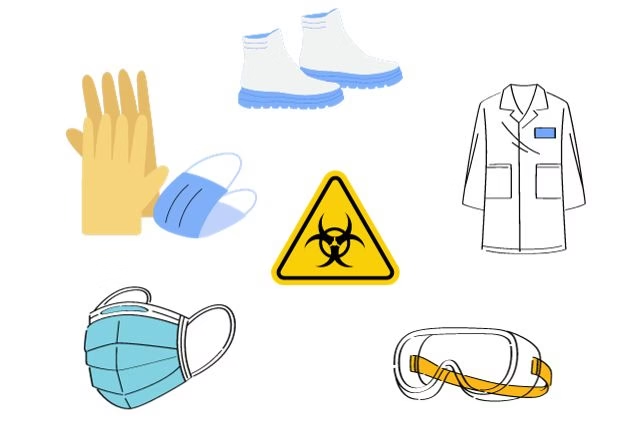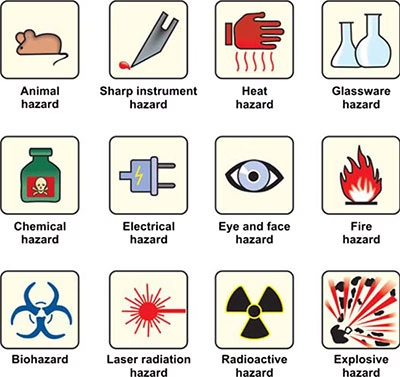
Hazards in Clinical Biochemistry
- Hazards in Clinical biochemistry involves the analysis of bodily fluids, such as blood and urine, to diagnose and monitor various medical conditions.
- While these processes are crucial for accurate diagnosis, there are several hazards involved, ranging from chemical exposure to biological risks.
- The following are some key hazards and safety considerations in clinical biochemistry.

Chemical Hazards
a. Reagents and Chemicals
-
Toxic Chemicals: Many reagents used in clinical biochemistry laboratories can be toxic if improperly handled. For instance, solvents like acetone, chloroform, and formaldehyde, along with acids and bases, pose serious health risks.
-
Carcinogenic Substances: Chemicals such as benzene, certain organic solvents, and formaldehyde are known to be carcinogenic and can increase the risk of long-term health problems if exposure is prolonged.
-
Corrosive Chemicals: Acids and alkalis used in laboratory analyses can cause skin burns, eye damage, or respiratory irritation. It is critical to handle these substances with proper protection like gloves, goggles, and lab coats.
b. Chemical Spills and Leaks
-
Accidental spills of chemicals can contaminate the workspace and pose immediate dangers. Procedures for cleaning and decontaminating the area must be in place to handle such emergencies.
-
Special care must be taken when using volatile solvents that can release harmful fumes.
Heat hazards
-
Hotplates and Bunsen Burners: These are commonly used in clinical biochemistry labs for heating reagents, samples, or for sterilization. Direct contact with these hot surfaces can cause severe burns.
-
Autoclaves: Used for sterilizing equipment, autoclaves reach very high temperatures and pose a risk of burns during loading or unloading if not handled correctly.
-
Water Baths: These are frequently used to heat biological samples. If the temperature is set too high, spills can lead to burns.
Glassware hazards
-
Breakage and Cuts: Glass tubes, beakers, flasks, and pipettes are common in clinical biochemistry labs. When mishandled or dropped, glass can break into sharp pieces, leading to cuts and lacerations. Handling broken glass can also introduce risk of infection if biological samples are involved.
-
Chemical Exposure: Many reagents used in clinical biochemistry are corrosive or toxic. If glassware is broken, there is a risk of chemical spills, leading to direct skin contact, inhalation, or eye exposure to dangerous chemicals like acids, bases, or solvents.
-
Contamination: Clinical biochemistry labs handle sensitive biological samples, and broken glass can cause contamination. If glassware containing samples breaks, it may lead to the release of potentially infectious or hazardous materials, increasing the risk of contamination in the lab environment.
-
Thermal Shock: Many glass containers, such as test tubes and flasks, are exposed to varying temperatures (e.g., in water baths or during autoclaving). Rapid temperature changes can cause glass to crack or shatter, posing a risk of injury or the release of hazardous substances.
-
Inhalation of Broken Glass or Particulates: In some cases, glass may break into very fine pieces. Inhalation of glass dust or fine shards, particularly in high-energy environments, can lead to respiratory issues.
-
Failure of Glassware in High Pressure or Vacuum: Certain glassware, such as bottles and flasks used under vacuum or pressure conditions, may fail if improperly handled or if the integrity of the glass is compromised. This can lead to rapid release of hazardous substances or injury.
Biological Hazards
a. Exposure to Infectious Agents
-
Bloodborne Pathogens: Clinical biochemistry often involves working with blood and other bodily fluids. Pathogens like HIV, Hepatitis B, and Hepatitis C can be transmitted through needle sticks or contaminated surfaces.
-
Microbial Contamination: Sample contamination with bacteria, viruses, or fungi can occur during handling and pose a risk to laboratory staff. Safe handling and proper disposal of biological waste are essential to reduce this risk.
-
Biological Waste: Proper disposal of biological waste, including human tissues, blood, and other specimens, is crucial to prevent contamination and disease transmission.
b. Aerosolization of Infectious Materials
-
Certain laboratory procedures, such as centrifugation or opening sealed vials, can lead to the creation of aerosols, which can potentially carry infectious agents. Specialized equipment, such as biosafety cabinets, is needed to contain and mitigate these risks.
Physical Hazards
a. Electrical Hazards
-
Clinical biochemistry laboratories typically contain various electrical devices such as centrifuges, incubators, and analyzers. Improper wiring, malfunctioning equipment, or wet conditions can lead to electrical shocks.
-
It’s important to ensure that all equipment is regularly maintained and that safety protocols are followed, including grounding of devices and use of circuit breakers.
b. Fire and Explosion Risks
-
Flammable chemicals, such as organic solvents, can present a significant fire risk, particularly if used improperly or stored incorrectly. Flammable gases like hydrogen or acetylene, used in some instruments, can also pose explosion risks.
-
Fire extinguishers, safety showers, and fire blankets should be readily available, and laboratory personnel should be trained in fire safety protocols.
Ergonomic Hazards
a. Repetitive Strain Injuries
-
Clinical biochemistry involves numerous repetitive tasks such as pipetting, sample preparation, and computer work. These activities can lead to musculoskeletal problems such as carpal tunnel syndrome, back pain, and eye strain.
-
It is important to adopt ergonomic work practices, take regular breaks, and use adjustable workstations to reduce the risk of repetitive strain injuries.
b. Prolonged Standing or Sitting
-
Long hours of standing or sitting during lab work can lead to fatigue, varicose veins, and lower back issues. Regular breaks and proper seating or standing arrangements can help mitigate these effects.
Radiation Hazards
a. Use of Radioactive Isotopes
-
Some diagnostic tests in clinical biochemistry may involve the use of radioactive isotopes (e.g., in radiometric assays). Radiation exposure can pose long-term health risks such as cancer or genetic mutations.
-
Laboratories must comply with regulations on radiation safety, including proper storage, handling, and disposal of radioactive materials. Personal protective equipment (PPE), such as lead aprons and gloves, should be worn to minimize exposure.
Psychosocial Hazards
a. Stress and Mental Health Issues
-
The high demands of accuracy, long working hours, and the need for constant attention to detail can lead to stress, fatigue, and mental health issues among clinical biochemists.
-
Implementing stress management strategies, regular rest periods, and promoting a healthy work-life balance can help mitigate these risks.
b. Fatigue from Night Shifts
-
Clinical biochemists often work around the clock in hospital settings, especially in emergency or intensive care units. Prolonged night shifts can lead to sleep deprivation, reduced alertness, and errors in laboratory results.
-
Rotating shifts and ensuring adequate rest are essential to maintaining productivity and reducing the risk of accidents.
Personal Protective Equipment (PPE) and Safety Protocols
a. Gloves, Goggles, and Lab Coats
-
To minimize exposure to chemical and biological hazards, laboratory workers must wear appropriate PPE. Gloves protect against chemical burns or contact with infectious materials, goggles shield the eyes from splashes or harmful chemicals, and lab coats protect the skin and clothing.
-
It is essential to select the right type of gloves for the specific chemicals or materials being handled, as some chemicals can permeate certain types of gloves.
b. Respirators and Face Shields
-
Respirators are crucial when handling volatile chemicals, infectious aerosols, or when working in areas where airborne hazards may be present. Face shields can be used to protect the face from splashes during high-risk procedures.
c. Decontamination Procedures
-
Regular cleaning of work surfaces, equipment, and disposal of used materials in designated containers help prevent cross-contamination and exposure to hazardous substances. Laboratories should have a decontamination protocol in place for cleaning equipment, instruments, and workspaces.
Risk Management and Safety Protocols
a. Training and Education
-
Continuous education and training on hazard identification, safe handling of chemicals, and emergency procedures are essential for laboratory personnel. Awareness programs can help mitigate risks and ensure safety protocols are followed.
b. Emergency Response Plans
-
All clinical biochemistry laboratories should have an emergency response plan for dealing with spills, chemical burns, fires, or biological contamination. Regular drills and mock scenarios help prepare laboratory staff to handle emergencies effectively.
c. Regulatory Compliance
-
Laboratories must adhere to local and international safety standards and regulations, such as OSHA, WHO guidelines, and others specific to clinical biochemistry. Regular audits and compliance checks are necessary to ensure that the laboratory is following proper safety practices.